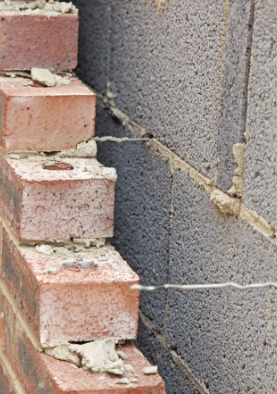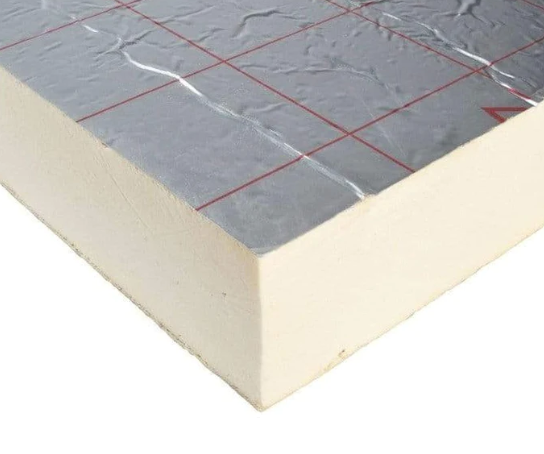Do thick walls make for warm houses?
I spend my days talking to homeowners about improving the efficiency of their houses. Everyone has heard about "fabric first," but I thought I would address a few misconceptions.
Your house is a box; inside, it's warm, outside, it's cold. The heat from your house leaks out, partly through drafts and partly through the walls, ceiling, floor and windows. It's just like a cup of tea; it starts off warm but slowly loses its heat. If you have a tin cup, the tea goes cold quickly. If you wrap the cup in insulation, the tea stays hot longer. In your house, you don't want it to go cold, so the rate at which it loses heat determines how quickly we have to top it up with the heating system and the cost to do it.
When I explain this to people, they say, "It's OK, I've got 600mm thick solid walls. The insulation is good." Unfortunately, that's not true. Thick walls do not necessarily mean good insulation. Let's explore.
Heat loss is measured in how many Watts of heat leak through the wall if it's 1 metre square and there is a 1-degree temperature difference from one side of the wall to the other. It's called a U-value. It's a useful tool to compare insulation. You can google most U-values. Lower is better. Zero is the dream; 0 = no heat loss.
Solid 600mm thick walls have a U-value of 1.68 W/m² K.
Solid 300mm thick walls have a U-value of 2.78 W/m² K. The heat leaks out of the thinner wall faster – no surprises there.
Since the 1920s, we have built houses with cavity walls, a 100-year-old cavity wall of brick, an air gap and blocks inside, as shown below. It has the same U-value as a 600mm solid wall, 1.6 W/m² K.

Filling the cavity with cavity wall insulation reduces this heat loss to 1.0 W/m² K, nearly halving the losses. That's why it's so popular; it makes sense and it's easy to do.
But it gets better. Celotex insulation is the stuff you buy in sheets covered in aluminium foil.

50mm thick Celotex has a U-value of 0.44 W/m² K. Or, to put that into context, 50mm Celotex lets only 1/4 the heat leak out, compared to a 600mm thick wall, and under half the leak rate of a cavity-filled wall.
The problem is it's hard to slide sheets of Celotex between the walls in an existing house. The only realistic solution is lining the walls of your house with Celotex. It makes a huge improvement in the insulation and massively reduces the heating costs. It's a great idea, but it's not easy to do without disrupting the house decorations. But if you are renovating, it's a very good idea to do it. And you can use it in the floors and ceilings to similar effect.
Nowadays, houses are built with a cavity filled with Celotex, normally 100mm thick. The total wall U-value is 0.18 W/m² K. That's nine times better than a 600mm solid wall.

Now you know why old churches and cathedrals are so cold.
Heat pump builder
How do you work out that "Solid 600mm thick walls have a U-value of 1.68 W/m² K" whilst "Solid 300mm thick walls have a U-value of 2.78 W/m² K"? Surely if 600 mm is 1.68 then 300 mm must be 3.36? i.e. double! (ignoring the surface resistances)
@djh if I remember rightly it’s to do with U and R values being reciprocal. Read this to get the idea
https://www.thegreenage.co.uk/article/thermal-conductivity-r-values-and-u-values-simplified/
House-2 bed partial stone bungalow, 5kW Samsung Gen 6 ASHP (Self install)
6.9 kWp of PV
5kWh DC coupled battery
Blog: https://thegreeningofrosecottage.weebly.com/
Heatpump Stats: http://heatpumpmonitor.org/system/view?id=60
Yes, I know about U & R values. That's exactly why I'm asking!
U = 1.68 W/m² K => R = 0.595 m²K/W
U = 2.78 W/m² K => R = 0.360 m²K/W
0.360 isn't half of 0.595
@djh apologies it was late and I didn’t really consider your question. It might be down to the effect of the wall covering. Using a U value calculator I got 2.43 and 1.56 with the wall covering automatically allowed for.
House-2 bed partial stone bungalow, 5kW Samsung Gen 6 ASHP (Self install)
6.9 kWp of PV
5kWh DC coupled battery
Blog: https://thegreeningofrosecottage.weebly.com/
Heatpump Stats: http://heatpumpmonitor.org/system/view?id=60
this is very interesting - so can we take this discussion further?
I’ve always thought mass is very useful in internal walls as it becomes a store which radiates slowly back into the living space…. Thereby reducing fluctuations in room temps say during an overnight setback.
whereas an external wall of high mass construction is a constant drain on the latent heat of a living space. I am assuming!!! Creating down drafts at the sides and corners of a room.
So would internal PIR insulation or external PIR cladding be better for a 600mm external walled building?
does insulated external mass help in any way to the comfort of the occupants?
this is very interesting - so can we take this discussion further?
I’ve always thought mass is very useful in internal walls as it becomes a store which radiates slowly back into the living space…. Thereby reducing fluctuations in room temps say during an overnight setback.
Whereas an external wall of high mass construction is a constant drain on the latent heat of a living space.
So, I am assuming!!! Creating down drafts at the sides and corners of a room.
So would internal PIR insulation or external PIR cladding be better for a 600mm external walled building?
Does Externally-insulated external mass help in any way to the comfort of the occupants?
while internally insulated walls will lower the internal mass of the living space and so not helping so much to store heat?
These are, I think important nuances which could be better understood.
Of course accuracy of quoted data makes for confidence and peace of mind.
Posted by: @sunandairDoes Externally-insulated external mass help in any way to the comfort of the occupants?
The terms 'high thermal mass' and 'fabric first' occur frequently in documents which accompany planning applications by the larger national construction firms.
They confuse the hell out of Councillors who are members of the Planning Committee.
I know that because I enjoy good communication channels with Councillors in my Local Planning Authority (LPA) and have the privilege of being asked by them about energy matters.
If nothing else this discussion topic must serve to better equip readers to write submissions to the LPA when multiple-dwelling applications are 'out for public consultation'.
Councillors are eager to receive submissions which explain matters to them, as opposed to residents who complain about 'non-material matters' which can't be taken into account.
An Application for 120 houses in my area was recently withdrawn by the developer because I'd picked up a number of their assertions and explained the technical aspects to the Council. Under the Planning Act my submission becomes a public document, available for anyone to view. Thus it serves as a 'warning' to planning agents for other companies considering a speculative application for inefficient houses in the district.
I substantially agree with @sunandair that high thermal mass is only effective it it's inside the insulation layer.
Posted by: @sunandairSo would internal PIR insulation or external PIR cladding be better for a 600mm external walled building?
I think you can now deduce my response to this!
But in practice most householders don't have such a choice to consider.
The existing building style dictates how they might be able to increase the insulation level.
My 1937 Devon ex-farmhouse has concrete blocks for both leaves of the wall, with a then-standard 50mm cavity.
Of course I have now had that cavity filled... funded by a Local Authority scheme about 16 years ago.
The ongoing renovation work has now progressed to the ground-floor room which is coldest - on the NE corner.
The floor has been removed and is being replaced.
It has new joists with PU solid insulation board between them and will be fitted with (wet) underfloor heating.
Most of the insulation boards come from Seconds and Co in Powys.
They may be under-sized, have a damaged edge, or surface 'bumps' due to faults in manufacturing.
That means they're half-price 😀
I bought a lorry-load in the various thicknesses I wanted, and they sit on pallets outside under tarpaulins until I'm ready for them.
Wall Insulation. There is an opportunity to add internal insulation to the East Wall, where a large fireplace is being removed.
As I already have a stack of 30mm insulation board (aluminium both sides), that's what I'll use.
Yes, I could also do the same for the North wall, but it has a large bay window.
I don't want to spend ages making new window reveals for minimal gain, so I'll leave that as-is.
So my contribution here is more 'hands on' than the theoretical proposals from Graham and Sun & Air.
But that might be useful to @beazy
I'll keep taking photos of progress.
Please ask for more detail on anything you see.
Save energy... recycle electrons!
@sunandair So my take on it would be that having the walls thermal mass inside the insulation layer, would act as a thermal store and be ideal for 24/7 heat pump installations. However if external thermal insulation wasnt feasible, it would still be worth insulating the inside of the walls, just the keep the heat inside even if no thermal store effect.
For non heat pump uses like a traditional boiler with lots of offs and ons in a day, it would probably be better to keep the insulation inside the walls, for speedier heat ups when the boiler was turned on.
House-2 bed partial stone bungalow, 5kW Samsung Gen 6 ASHP (Self install)
6.9 kWp of PV
5kWh DC coupled battery
Blog: https://thegreeningofrosecottage.weebly.com/
Heatpump Stats: http://heatpumpmonitor.org/system/view?id=60
@bontwoody
A lot of the reason the u value doesn’t scale with 1/wall thickness is because in-situ insulation also includes air boundary layers. That’s why single glazed windows get a u of 6, rather than some insanely high value just associated with the glass (glass lambda is 1.1, so a 4mm pane of glass alone has a U=275W/m2/degC 🤨 ). Indoors for vertical surfaces the still air boundary layer is generally 8W/degC/m2, outdoors it depends on wind speed, I think 20 is often the assumed default.
@robl Thanks, thats interesting 🙂
House-2 bed partial stone bungalow, 5kW Samsung Gen 6 ASHP (Self install)
6.9 kWp of PV
5kWh DC coupled battery
Blog: https://thegreeningofrosecottage.weebly.com/
Heatpump Stats: http://heatpumpmonitor.org/system/view?id=60
-
Seal the Deal: Don't Let Your Heat Pump Leak Energy
2 months ago
Currently viewing this topic 1 guest.
- 26 Forums
- 2,342 Topics
- 53 K Posts
- 503 Online
- 6,000 Members
Join Us!
Worth Watching
Latest Posts
-
RE: Setback savings - fact or fiction?
Two days will never be sufficient because the run up an...
By JamesPa , 6 minutes ago
-
RE: Poll for Time of Use, tariffs, technology
I dont know TBH. Quotes for installed batteries seem v...
By JamesPa , 24 minutes ago
-

RE: LiFePO4 lithium battery fires and explosions
That's somewhat of an understatement. 🤨 The ...
By Transparent , 6 hours ago
-
RE: Help me keep the faith with my air source heat pump installation
@simonf thats interesting as I’ve noticed my flow and r...
By AdamK , 7 hours ago
-

RE: MELcloud scheduling misbehaviour
No, it gets to set temperature easily even during perio...
By Abernyte , 8 hours ago
-
RE: Free Ecoheat Heat Pump Install
Sorry hit 'add reply' too early, this forum layout will...
By Deltona , 9 hours ago
-
And arguably even more important, sodium will be hopefu...
By Batpred , 12 hours ago
-
RE: A Smarter Smart Controller from Homely?
I've been thinking of emailing Homely to ask for a few ...
By JohnnyB , 1 day ago
-
Max output of Heat pump (Daikin 4Kw EDLA04)
Hello, I am a bit puzzled that according to pcdb tes...
By GeorgeA , 1 day ago
-

In that case, @technogeek, I’d sign up for the free sol...
By Majordennisbloodnok , 1 day ago
-

RE: Has Anyone Else Noticed a Decline in Tradesmanship?
@cathoderay Hence my rider about ‘all else being equal’...
By Toodles , 1 day ago
-

RE: Heat Pump Performance Analysis Web App using Modbus Data
@redzer_irl — all my heat pump data is in csv files, me...
By cathodeRay , 1 day ago
-

That’s not a problem. If you can hit the main landing p...
By Majordennisbloodnok , 1 day ago
-

RE: Configuration issues with 10kW Midea R32 heat pump
@benson I believe there are quite a few of these instal...
By Toodles , 1 day ago
-
RE: 10kw heat pump run in 24*7 data?
I would say you most likely do need 10kW. My gas consu...
By JamesPa , 1 day ago
-
RE: Mitsubishi Ecodan 11kw Defrosting Issue.
@thundermink I managed to find the fault. I did it a lo...
By meehow , 1 day ago
-
RE: Here is my heat pump installation with questionable COP in Italy
Well in Italy there is nothing controlling the quality ...
By materox345 , 1 day ago
-

RE: What a Bad Heat Pump Installation Looks Like
@editor The trick to an inside unit installation is to ...
By MikeFl , 2 days ago










